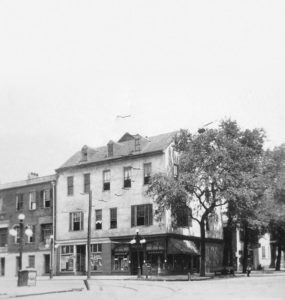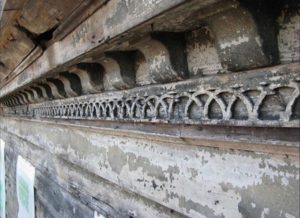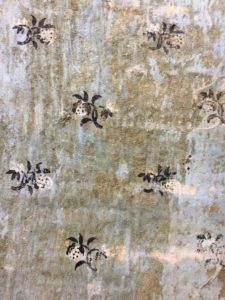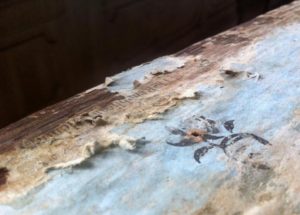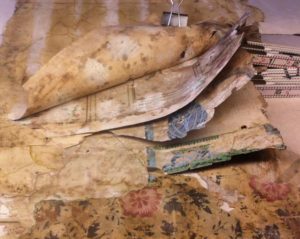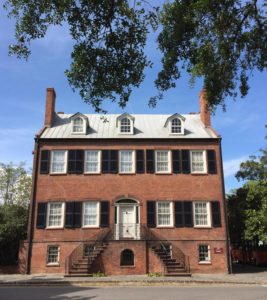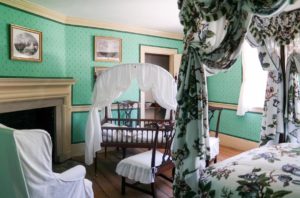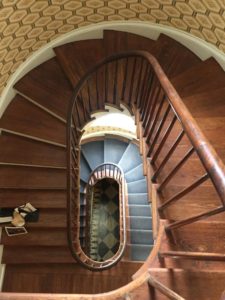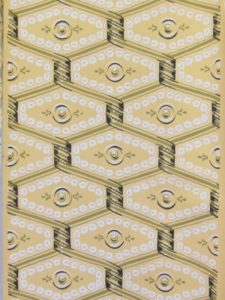Wallpaper Discoveries at Savannah’s Berrien House
EVENTS > SYMPOSIA
In Review: The Decorative Arts Trust Spring Symposium, 2017
The Berrien House’s rediscovery began in 2007 when the house was owned in foreclosure by the Queensborough National Bank. Although derelict, the exterior was under easement thanks to the efforts of the Historic Savannah Foundation. The dearth of interested buyers at the time—the house’s reputation as a money pit was well-known in the local preservation community—led the bank to consider opening a branch on the ground floor, while converting the upper floors into apartments.
The bank hired a local architectural firm to produce a set of “as built” drawings of the structure. Architect and preservationist David Kelley was assigned to the project. David’s first memories of the house were that “it was boarded up, nasty, and scary.” Despite the house’s deplorable condition, David could tell there was interesting historical material to be uncovered.
The house was built in 1791 for Major John Berrien, a Revolutionary War veteran, whose family’s house near Princeton, NJ, served as George Washington’s headquarters in 1783. Berrien’s son, John MacPherson Berrien, a prominent lawyer and politician, lived there from 1822 until his death in 1856. Lending additional significance is the house’s standing as a rare survivor of the devastating fires that swept through the city in 1796 and 1820, destroying much of Savannah’s 18th-century architecture.
Just as David was finishing his initial drawings of the house, the recession of 2008 brought the project to a sudden halt. The bank, leery of the high cost estimates, started looking for buyers. Serendipitously, one came forward almost immediately. Enter Andrew Jones, who has spent his career in New York but happens to be a Berrien descendant, as well as a relative to almost every other prominent Savannah family. Andrew had seen the house before and was keeping tabs on its progress for years. Needless to say, he jumped at the opportunity to bring the property back into family ownership.
David and Andrew quickly became a formidable team, as both shared an eagerness to uncover the home’s full history. Their goals were two-fold: to stabilize and restore the exterior and properly study the interior for historical evidence. The exterior of the house was a major challenge in its own right. The original elevated basement had been enlarged into a ground floor with store fronts, which required the whole structure to be lowered back to its initial height and the portico restored. Fortuitously, the original cornice was discovered largely intact behind later construction.
The interior held bigger surprises, but only after a good deal of “exploratory demolition” (to use David’s turn of phrase). For the casual observer, the strips and scraps of old and faded wallpaper that emerged as carpenters pried away layers of fiberboard and plaster were not much to look at. Fortunately, word of what was being found under the house’s walls started to spread around town, and David received a call from Maryellen Higgenbotham, a professor of historic interiors at Georgia State University, asking if she could help document the wallpaper. David readily accepted and the visit has led to many years of subsequent research and collaboration with the aim to publish a book on their discoveries.
The importance and impact of the Berrien House wallpaper discovery cannot be overstated. Shortly after the project restarted, Jamie Credle, Director of the nearby Davenport House, was looking for a design found in Savannah at the time of its construction circa 1820 to be reproduced for their foyer. She contacted Andrew and David to borrow samples, and a “sandwich” of wallpaper was sent to Steve Larson of Adelphi Wallpapers in upstate New York for analysis. The appropriately dated Berrien pattern that emerged was a repeating “ribbon trellis” with a dentil border, and the necessary printing blocks were made to produce the paper. During the process, Larson contacted David, impressed that many of the “sandwich” remnants were incredibly rare examples of sidewall and border designs, including hand-painted French and English papers.
While Andrew and David both realized the full importance of the Berrien House’s secrets, the effects kept snowballing. George Washington’s Mount Vernon recently reinstalled the Chintz Bedroom on the mansion’s second floor, believed at one point to have been used by Martha Washington’s granddaughter, Nelly Custis Lewis. Working from a small fragment of a sprig pattern on a verdigris background, Associate Curator Amanda Isaac discovered a perfect match in the “Berrien House Sprig” found in Adelphi’s catalog.
Subsequent findings have strengthened the connection between the Savannah Berriens and their mid-Atlantic origins. As previously mentioned, John Berrien was raised near Princeton. His two wives were both from Philadelphia, including the daughter of Scottish ship captain John Macpherson, who built Mount Pleasant in the city’s Fairmount section. When further layers of wallpaper were uncovered, the original backing and linings between the wall boards turned out to be Philadelphia newspapers from 1796-97. David believes the Berriens likely purchased their wallpaper in Philadelphia, which was sent to Savannah wrapped in newspaper reused for this purpose.
Work remains ongoing at the Berrien House, with David as the head of the preservation team. The city recently granted a permit for the next round of interior renovations, and the team is finalizing work on the wallpaper. What remains on the walls will be protected and covered for future study, and Andrew is seeking an institution to conserve and permanently house samples removed from the walls. David feels very fortunate to be working on such a fascinating project, and we should all be grateful for Andrew Jones’ dedication to an academic and exhaustive investigation of the Berrien House.


